
In ice and field hockey, the slot refers to the area extending toward the blue line. The word slot is related to the verb sleutana and is cognate with German Schloss. In addition to the hockey term, the slot has numerous other definitions. Here are some of them: The Payback percentage, the number of games between “stocks” released, and the Rules for winning at slots.
Payback percentages
Payback percentages refer to how much of your money you can expect to win on a slot machine. This percentage depends on several factors, including the paylines on the machine and the theme of the game. Generally, you will want to play machines with higher payback percentages. They are calculated using a formula that divides a large number by a standard one. The higher the payback percentage, the better your chances are of winning. You should also consider the random number generator and the number of paylines in a machine.
The payback percentages for slot machines differ by casino. The highest paying machines are those found in Las Vegas casinos. In contrast, low paying machines are located in less competitive casinos. Payback percentages for slots are usually higher than those of video poker, keno, and video poker. This difference is significant – it can mean more or less money in an hour!
Probabilities of hitting symbols
If you play slot machines, knowing the probabilities of hitting slot symbols is essential for boosting your chances of winning big. There are some simple math formulas that can help you calculate the chances of hitting a particular symbol or combination of symbols. Using these formulas will help you determine your chances of hitting a winning combination and the payback rate.
The most basic formula to determine the chances of hitting a slot symbol is the number of symbols on a row. The higher the number of symbols, the better the odds of hitting the jackpot. For example, if you hit the jackpot symbol four times on a row, you have a one in six66 chance of hitting it. The best way to maximize your odds is to play on five-reel slots, as they offer better odds and allow you to play for higher stakes.
Rules for winning at slots
There are a few general rules that can help you win at slots. The first rule is to understand the mechanics of the game. Learn the paytables for different types of slots. You should always read through the paytable before starting to play. It will also be helpful if you know the rules for winning at different machines.
The main goal of slot machines is to create winning combinations along paylines. When you play slots, matching symbols must appear on the paylines. The payout will depend on the number of matching symbols that appear across the paylines. The game has many different types of paylines, and you can play slots with as many as twenty paylines.
Examples of slot-based schedules
Slot-based schedules help teams and individuals stay on task. They can be set up for hour-long blocks, weekly timeframes, or long-term timelines. A slot-based schedule makes it easier to manage time and prioritize tasks, which can help improve productivity. If you use slot-based scheduling in your organization, you may find it more effective than a daily or weekly calendar.
In a slot-based schedule, the UE determines the number of frames, called slots. It then determines the symbols that fall into the slots. These symbols may be DL, UL, or guard. If the symbol of a DL is present, the slot is a DL slot.